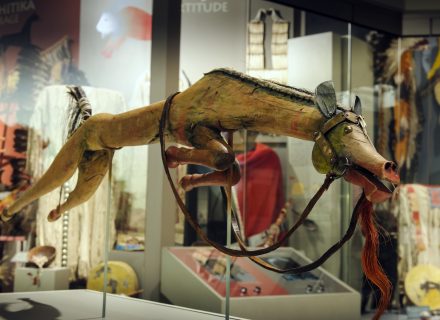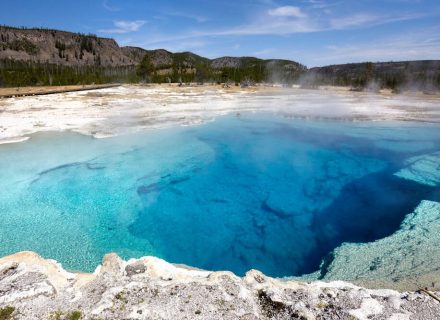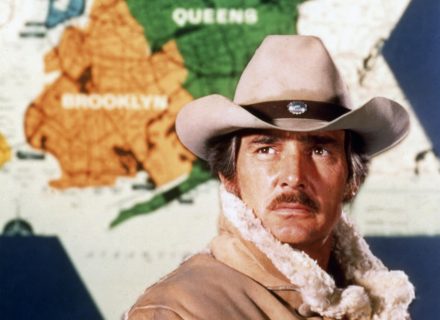Welcome to the rodeo! Oh, say can you see the flag waving, the chute opening, and the dust flying? Come with us to some of the summer's top rodeos.
Sit in the packed arena stands on any given weekend, turn up Garth Brooks’ 1991 hit single “Rodeo” extolling the “dust and the mud” and the “bulls and the blood,” peruse photographer Andy Anderson’s dramatic Montana series “All the Bucking Horses” — there’s proof everywhere that the sport of rodeo continues to captivate hundreds of thousands of spectators, drawing top competitors from around the country and providing some of the best entertainment on dirt.
To borrow from Garth again, “It’s the ropes and the reins, and the joy and the pain. And they call the thing rodeo.”
The term rodeo comes from the Spanish rodear, meaning “to surround” or “go around.” First used in American English about 1834 to denote a “round up” of cattle, the word and the activity it describes might date from the 16th century, when Spanish conquistadors introduced horses and cattle in the Southwest. In the 1800s, American cowboys and Mexican vaqueros working the vast cattle ranches of the region would have riding and roping contests. Their competitive cowboying became a form of entertainment, eventually evolving into the organized professional sport we know today.
It's thought that the first rodeo took place more than a hundred years ago in Deer Trail, Colorado, during a cowboy feud over who was best at breaking wild horses. The competition became our modern saddle bronc riding event. Today’s most popular events include tie-down roping, team roping, steer wrestling, bareback bronc riding, bull riding, barrel racing, and, of course, saddle bronc riding. In the 21st century, women’s events get stronger and stronger. In addition to barrel racing, breakaway roping has become one of rodeo’s most popular events, and junior bull riding can now be seen along with good old mutton bustin’.
So put on your best pressed Wranglers, boots, and hat and head out for some rodeo action this summer. Here are some of the season’s best.
THE DAYS OF '76
Deadwood, South Dakota
July 25 – July 30
The “Days of ’76” that give this famous rodeo its name hark back to the year 1876, when miners, muleskinners, and ultimately madams came to settle in the Dakota Territories and the discovery of gold in the southern Black Hills set off one of the great gold rushes in the country’s history. The Black Hills Gold Rush would fuel Deadwood’s heyday from 1876 to 1979, drawing icons of the Wild West like Wild Bill Hickok, Calamity Jane, and Wyatt Earp, and as many as 25,000 residents at the town’s population peak.
The Days of ’76 Rodeo first kicked off a century ago as a way to pay tribute to those first Deadwood pioneers. This year, the rodeo celebrates 100 years, easily making it Deadwood’s longest-running annual event. Honored as the PRCA Rodeo of the Year 19 times, the six-day rodeo attracts the best cowboys and cowgirls around the world.
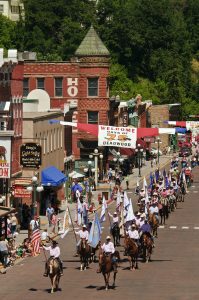
In addition to “the best contestants and stock in the business,” rodeo clown Justin Rumford will be bringing his unique form of comedy to entertain the audience. With the town’s geography limiting the rodeo’s size — Deadwood, which is situated at more than 4,500 feet in the northern Black Hills, lies in a canyon — it hasn’t been possible to add women’s breakaway roping (a special roping event is planned for August, though). Saddle bronc riding remains a fan favorite.
“What makes us so special is that we embrace tradition, down to old wooden bucking chutes,” says Chris Roberts, a board member of the Days of ’76 and chairman of the 2022 event. “What the spectators can see are acts that belong in Deadwood, like horse-drawn and other wagon reenactments.” This year, the rodeo will be reenacting the killing of Wild Bill Hickok in August of 1876 and a stagecoach holdup that took place more than a hundred years ago. “These historical embellishments make the Days of ’76 much different than other rodeos,” Roberts says.
Historic parades will stretch along Deadwood’s Main Street on Friday and Saturday, and Native American dance will be spotlighted at the Paha Sapa Cowboys & Indians Art Festival in Outlaw Square. As far as other things to see and experience, it’s all about the Old West in Deadwood, including the Gold Rush-era architecture that earned the entire town its designation as a National Historic Landmark District, and the Days of ’76 Museum, where visitors can learn about the rodeo’s inception and the mile-long historic parade. “The museum spotlights the city’s past cast of characters, and a huge collection of historic rifles,” Roberts says. “Other sites of interest include the Adams Museum and the Mount Moriah Cemetery, where Wild Bill Hickok and Calamity Jane are buried.”
The Days of ’76 Rodeo, 18 Seventy-Six Drive, Deadwood, South Dakota, 800.999.1876, daysof76.com
LIVINGSTON ROUNDUP RODEO
Livingston, Montana
July 2 – July 4
Who would ever guess that the Livingston Roundup Rodeo has its roots in New York City with Charlie Murphy, a Livingston local who was overseeing the stock at Madison Square Garden Rodeo in 1924. Murphy brought 28 of his top bucking horses from the Big Apple back to Montana, and the next year the Roundup Rodeo was born in Park County. Farsighted local businessmen expanded the roundup to include riding, roping, and bull-dogging contests for the amusement of Livingston citizens, making the event one of nine Class A rodeos in the country.
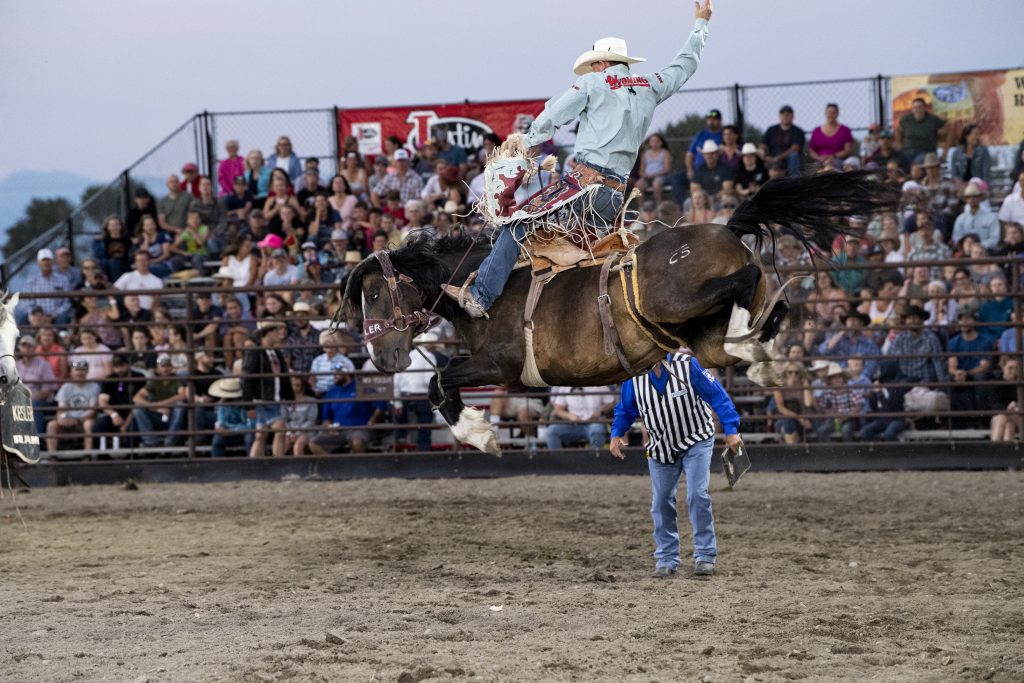 Livingston Roundup Rodeo, Park County Fairgrounds and Parks, 46 View Vista Dr., Livingston, Montana, 406.222.3199, livingstonroundup.com
Livingston Roundup Rodeo, Park County Fairgrounds and Parks, 46 View Vista Dr., Livingston, Montana, 406.222.3199, livingstonroundup.com
Ninety-eight years later, what better place to kick off the Fourth of July weekend than at the Livingston Roundup Rodeo. The three-day event boasts some of the best of summer arena action, as well as some of the top roughstock in the West. “We’re an evening rodeo, starting at 8 p.m.,” says Bruce Becker, president of the Livingston Roundup Rodeo Association. “We always have a sold-out crowd — we sell 15,000 tickets over the three nights.”
Becker says they’d love to add breakaway roping to the events, but they don’t have enough room. “It takes three times as much space when you run cattle in an arena,” he says. “If we have a hundred breakaway ropers, we would need 33 calves.” But they’ve added slack for overflow contestants, who can compete on July 1st and 5th. “Barrel racing is so popular, that in addition to the 15 riders who compete during regular rodeo, another 100 compete on July 5th and can go on to win a main event.”
Becker calls the Roundup, as it’s known locally, a destination rodeo — it’s just 50 miles from Yellowstone National Park. “Many tourists will plan their summer vacation around a visit to the park and then rodeo. There is also a smaller rodeo in Red Lodge and one in Cody, Wyoming, the same weekend. Between the three rodeos, there is more than $600,000 up for grabs and the cowboys can compete in all of them.”
PIKES PEAK OR BUST RODEO
Colorado Springs, Colorado
July 13 – July 16
The Pikes Peak or Bust Rodeo has been around since 1937, but its roots go back to the Shan Kive, a Ute homecoming celebration that took place 1911 – 1913. The oldest continuous residents of Colorado, the Utes were forced from their ancestral and aboriginal homeland there and banished to barren lands farther west when pioneers moved in. Forbidden to ever return, they celebrated finally being able to with a pilgrimage from Utah to Colorado Springs. Led by Chief Buckskin Charlie, aka Sapiah, the Utes celebrated with a festival that included horse races and riding contests when they reached the land of their sacred Tava-kaavi (Pikes Peak).
For several decades, the rodeo didn’t have a permanent home; that changed when Colorado Springs founder Spencer Penrose worked with the city to build the 10,000-seat Will Rogers Stadium, which was renamed the Spencer Penrose Stadium upon his death. Now rodeo athletes compete in the invitational championship rodeo in the state-of-the-art Norris-Penrose Special Events Center, which boasts a beautiful recently renovated arena.
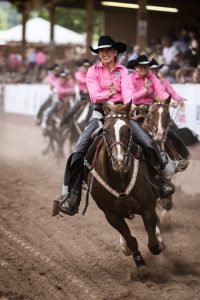
In 2022, the four-day event will rise to a new level of excitement when the best in pro rodeo come to Colorado Springs and the Pikes Peak or Bust Rodeo, in partnership with Cinch, welcomes for the first time the 2022 National Finals Rodeo Open, one of the biggest rodeos of the 2022 Pro Rodeo season. While exciting entertainment is the rodeo’s goal, the event’s inspiration is fundraising to support the local military — with close to $4 million raised to date.
“Rodeo winners from the twelve regions in Canada will come to Colorado Springs to compete in the National Finals Open,” says Scott Johnson, vice president of Pikes Peak or Bust Rodeo. “Winners from the National Finals December Rodeo will also be competing here locally. This rodeo will be second only to the Las Vegas-based national finals in talent and scope, with a million dollars in prize money and televised on RFD TV.”
Johnson says the rodeo is very user-friendly. “We keep it to a taut two hours,” he says. “As far as excitement goes, women’s breakaway roping will be featured every evening here for the first time — it’s definitely the new game in town. This is a quick two- or three-second event with about 24 competitors. Saturday night competitive bull riding is a fan favorite led by all-time money winner J. B. Mooney.”
Johnson suggests rodeo attendees experience Colorado Springs’ cultural renaissance by visiting the new Olympic and Paralympic Museum downtown as well as taking a train trip on the newly renovated historic Manitou and Pikes Peak Cog Railway up to the top of “America’s Mountain.”
The Pikes Peak or Bust Rodeo, Norris-Penrose Event Center, 1045 Rio Grande St., Colorado Springs, Colorado, 719.635.3547, pikespeakorbust.org
CHEYENNE FRONTIER DAYS
Cheyenne, Wyoming
July 23 – July 31
Touted as the “World’s Largest Outdoor Rodeo and Western Celebration,” Cheyenne Frontier Days has been around since 1897, earning it the loving nickname “The Daddy of ’Em All.” These days it’s known for blending great sport with great entertainment — 10 full days of music, kids activities, Western-themed events, and, naturally, rodeo. It consistently makes annual lists of top summer festivals in the country.
“Sometimes it looks like a three-ring circus, where kids can enjoy steer riding and other activities,” says Cheyenne Frontier Days CEO Tom Hirsig. “A big draw is the Riata Ranch Cowboy Girls, who come in from California and will be entertaining our audiences daily with trick riding and roping, and even shooting. Perhaps the biggest hit of the rodeo is the colt races, where the young colts run to their mothers across the arena. Breakaway roping is also a fan favorite — women have been favorites at the rodeo since the early days.”
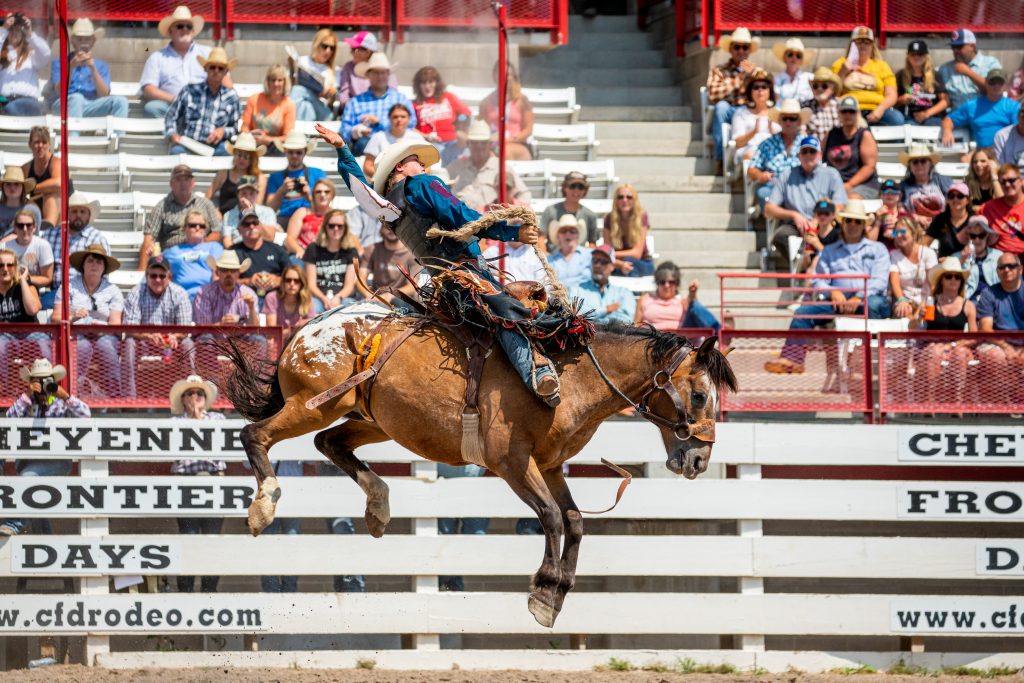 Cheyenne Frontier Days, 4610 Carey Ave., Cheyenne, Wyoming, 800.426.5009, cfdrodeo.com
Cheyenne Frontier Days, 4610 Carey Ave., Cheyenne, Wyoming, 800.426.5009, cfdrodeo.com
Last year commemorated the rodeo’s 125th anniversary, when concert headliners included Garth Brooks and Ned LeDoux. That year also marked the 50th anniversary of Wyoming native Chris LeDoux’s release of the album Songs of the Rodeo Life. LeDoux — a beloved hall of fame rodeo champ and singer-songwriter — has become synonymous with Cheyenne Frontier Days, and a statue of him atop a bucking bronc, unveiled in the big anniversary year, now greets visitors to Frontier Park.
In addition to traditional rodeo, Professional Bull Riding (PBR) will return to the CFD arena for two nights, July 25 – 26, boasting the rankest bulls and the toughest cowboys in the world going head-to-head on the Wyoming dirt. The event will serve as the launch for the inaugural PBR Teams season, the first team-based league in the sport of bull riding. The series’ initial 10-event, 112-game regular season will include a three-day home-venue event hosted by each of the eight founding teams, including the team owned by Teton Ridge, the Arizona Ridge Riders. The PBR “Ridge Rider Days” will be held at the Gila River Arena in Glendale, Arizona, October 14 – 16.
It’s easy to spend a whole week at Cheyenne Frontier Days without leaving the venues, except maybe to sleep. “For several mornings you can attend one of the parades, and on the other mornings we offer a pancake breakfast,” Hirsig says. Sometimes that means feeding upwards of 10,000 people, a feat that requires mixing the pancake batter in cement mixers. “Next, perhaps a visit to Frontier Town for some shopping, or enjoy Native American dancing and storytelling at the Indian Village in the morning. The rodeo starts at noon, and the day finishes with one of our first-rate concerts.”
THE RENO RODEO
Reno, Nevada
June 16 – June 25
The state of Nevada declares it the “Wildest, Richest Rodeo in the West.” Whatever superlatives apply, the Reno Rodeo delivers 10 days of family fun, and the PRCA-sanctioned event frequently features in USA Today’s Top Ten Reader’s Choice.
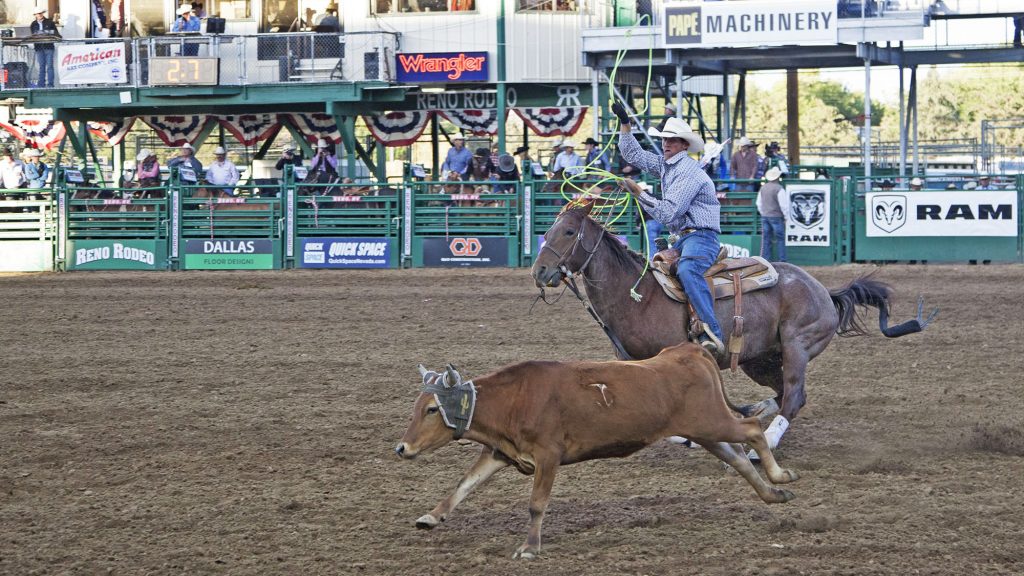 The Reno Rodeo, Reno, Nevada, Reno-Sparks Livestock Events Center, 1350 N. Wells Avenue, Reno, Nevada, 775.329.3877, renorodeo.com
The Reno Rodeo, Reno, Nevada, Reno-Sparks Livestock Events Center, 1350 N. Wells Avenue, Reno, Nevada, 775.329.3877, renorodeo.com
More than 140,000 fans attend each year. Now the fourth richest rodeo in the country, the Reno Rodeo comes from humble beginnings. More than a hundred years ago, the Commercial Club — the precursor to the Reno Chamber of Commerce — decided to create a “carnival” of sorts to celebrate the end of World War I and highlight some of the state’s “finest herders of cattle” and “pro-claimers” of horsemanship. The first time out of the chute, the event was dubbed the Nevada Round-Up, with the hope to bring large a large number of visitors and locals alike to see these rodeo events. It worked, and as of the 21st century, the now named Reno Rodeo has brought in over $52 million to the local economy.
Even though the Reno Rodeo is steeped in a century of Western tradition, the city of Reno is a modern destination full of casinos and a vibrant night life. Reno Rodeo general manager George Combs calls the area a great vacation spot, with the rodeo front and center. “Not only are we a Top 5 Rodeo in the country out of 650 rodeos, but our spectators get to see the best that rodeo has to offer, including mutton busting and wild-pony races,” he says. “This year we’re going to be bringing in miniature bull riding for the kids. We have two arenas, and we’ve got events are going on all day in one arena, with highlighted events taking place in the other arena at night.”
"Women’s barrel racing has really become popular,” Combs says, “and after testing women’s breakaway roping — a new sport that has garnered a lot of enthusiasm — we brought it back as a full rodeo event last year, and it was very well-received.”
Roping events go on for four days, then the rodeo wraps up with the final two evenings of the best performances, and Diamonds in the Desert, a high-end horse sale, where horses range in price from $20,000 to $100,000.
Although there are lots of golf courses and casinos in Reno, for Combs, the standout must-visit is beautiful Lake Tahoe, a 45-minute drive from the action and “a treasure for the Reno area.”
From our July 2022 issue














